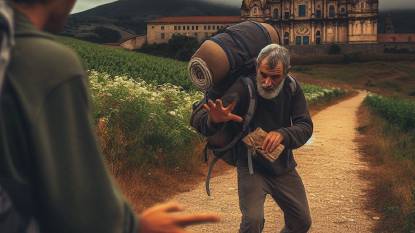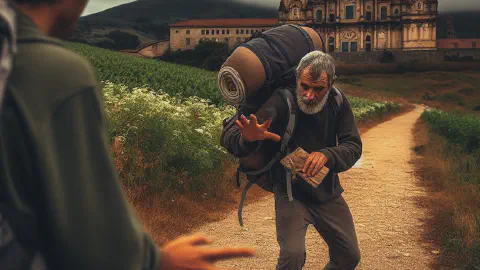
Is Theft a Problem on the Camino de Santiago?
Posted: | Updated:
Reading time: 23 minutes
Is Theft a Problem on the Camino de Santiago?
Posted: | Updated:
Reading time: 23 minutes
By: Simon Kemp, Editor
TLDR: No, the Camino is relatively safe and theft is not too much of a problem if you take some reasonable safety precautions and are a little streetwise. Here are some tips to prevent you from becoming a victim and keep you and your belongings safe.
The Camino de Santiago pilgrimage routes, known collectively as the Camino, have historically been viewed as a haven for spiritual discovery and self-reflection, where instances of petty crime were rare. However, in recent years, there has been a slight increase in robbery cases reported by pilgrims.
While statistically the Camino is still considered relatively safe when compared to other tourist hotspots, the number of incidents cannot be overlooked. It is notable that the petty crime appear to be more prevalent during the peak pilgrimage months of summer, a period that coincides with an influx of pilgrims. So let’s discuss theft on the Camino de Santiago, how common it is and how to prevent it.
What Are the Most Targeted Items by Thieves on the Camino?
Among the commonly targeted items, electronic devices such as smartphones, digital cameras, and portable chargers top the list. These items are coveted not only for their monetary value, but also because they are easily portable and resalable. Additionally, cash and credit cards also often fall victim to stealing, particularly in populated sleeping quarters known as “albergues,” where pilgrims are often in close proximity with their belongings at risk.
A disturbing trend seen recently also includes thieving of passports, a particularly problematic issue considering the international nature of the Camino’s pilgrim population. Both the extent and nature of these incidents pose a threat to the safety and peace of mind of the pilgrims on the Camino.
It is worth repeating that the summer months are a hive of pilgrim activity, and that activity attracts thieves who prey on tired travelers. If you are doing a Camino in winter , then you have far less to be worried about.
Who Are the Thieves and What Drives Them to Steal from Pilgrims?
Recognizing the source of a problem serves as a first step towards tackling it. In the case of theft on the Camino, the perpetrators are mainly opportunistic criminals drawn to the area by the influx of tourists and pilgrims every year. These individuals, often non-locals, target the Camino specifically for its heavy foot traffic and the tendency of pilgrims to carry cash or valuables. Misguidedly, they believe that stealing is a viable way to supplement their income.
Digging deeper into their motivations, one cannot ignore the socio-economic contributions. Many of these incidents can be traced back to issues such as poverty, unemployment, or drug addiction. This makes the Camino a practical hunting ground for thieves looking to exploit unsuspecting tourists.
Understanding these factors doesn’t justify the wrongdoings but gives us an insight into why petty crime continues to be a persistent issue on the Camino. With this knowledge, pilgrims, tourists, and even authorities can comprehend the situation better and come up with more effective preventative measures.
How Does Theft Affect the Victims and the Spirit of the Pilgrimage?
The consequences of these incidents on the Camino are impactful not only on an individual level but also on the collective experience of the pilgrimage. Victims often report feelings of violation, betrayal, and distress following an incidence of petty crime.
These negative emotions can significantly dampen the enthusiasm and excitement typically associated with the pilgrimage journey. The financial burden and inconvenience of replacing stolen items can detract from the overall experience. Lost essential items, such as passports, bank cards, and electronic devices, can create significant logistical obstacles and put a severe damper on the journey.
The prevalence of theft also negatively affects the overall spirit of the Camino pilgrimage. A sense of camaraderie and mutual trust among pilgrims is a defining aspect of the journey. With rising occurrences, faith in this communal bond can be seriously undermined.
Fearing crime prompts changes in behavior among pilgrims, such as increased vigilantism and suspicion towards fellow travelers. These alterations in communal dynamics can disturb the harmony intrinsic to the Camino experience, therefore diminishing the unique spirit of this respected pilgrimage.
The aftermath of any misdeed on the Camino has significant impacts at both personal and collective levels. Victims frequently express feelings of violation, betrayal, and distress. These negative emotions can greatly diminish the enthusiasm and excitement that typically accompany a pilgrimage journey.
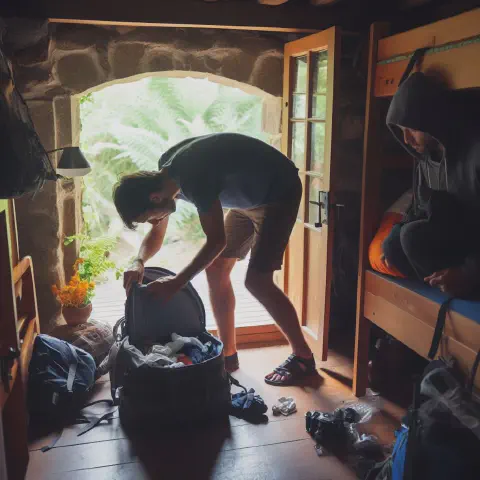
How to Avoid Being Robbed on the Camino: Best Practices and Tips
What are the best practices and tips to avoid being robbed? Especially if you are a solo traveller or a solo female Pilgrim. How do you keep safe as a lone female on the Camino? One of the most effective strategies to deter potential thieves on the Camino de Santiago is being vigilant about personal belongings. Pilgrims are advised to keep essential items such as passports, money, and credit cards on their person at all times, preferably in a concealed pouch around the neck or waist.
Pacsafe travel bags, money belts or anti-theft backpacks equipped with lockable zippers and cut-proof materials significantly reduce vulnerabilities to sneak snatching incidents. Investing in small padlocks to secure luggage can also serve as an effective deterrent for opportunistic thieves.
Adopting measures to thwart theft doesn’t end with the secure handling of possessions. Pilgrims should maintain an acute awareness of their surroundings, particularly in crowded public areas and accommodations.
Be wary of leaving any belongings unattended, and get into the habit of checking if all your belongings are intact, especially after taking a break. Be cautious when revealing travel plans or sharing personal information, as thieves might be eavesdropping. Remember, prevention is worth a pound of cure when it comes to safeguarding possessions along your journey.
How to Deal with Theft on the Camino: What to Do and Who to Contact?
What to do if you are a victim and how to get help from the authorities and fellow pilgrims? First and foremost, victims on the Camino should immediately report the incident to the local police. The process may seem daunting, especially with a language barrier. The translations of “Police” are the same in Spanish and Galician, see below:
- English: Police
- Spanish: Policía
- Galician: Policía
Acquiring a police report is essential, especially for travel insurance purposes and to aid in the ongoing investigation to apprehend the culprits. There are several English-speaking police stations along the Camino route, which makes it easier for an American or UK pilgrim. Although you may be distressed, it is critical to stay calm and provide the authorities with as much detail about the incident as possible.
Remember the three primary details:
- What was stolen?
- Where did you last see it?
- When did you notice it was missing?
The Police in Spain
In Spain, there are three different types of police: the National Police (Policía Nacional), Local Police (policía local), and the Civil Guard (Guardia Civil). Each has its own specific responsibilities and jurisdictions:
- National Police (Policía Nacional): The National Police is a civilian force that operates mostly in urban areas. They are primarily responsible for policing urban areas, overseeing compliance with national laws and criminal justice codes, protecting lives, personal property, and goods, safeguarding public buildings and facilities, maintaining and/or restoring public order and security, and preventing crime. They also handle criminal investigation, judicial, terrorism, and immigration matters.
- Local Police (policía local): The Local Police are armed police officers whose main duties include control of traffic in their municipalities, protection of public buildings, conducting crime investigation duties in cooperation with the State Police, reporting of traffic accidents in urban areas, guarding municipal buildings, enforcing local ordinances, and monitoring public demonstrations.
- Civil Guard (Guardia Civil): The Civil Guard is a national gendarmerie force with military status. They are primarily responsible for law enforcement in all Spanish territory, excluding cities above 20,000 inhabitants, highway patrol, protection of the King of Spain and other members of the Spanish Royal Family, military police as part of military deployments overseas, counter drugs operations, anti-smuggling operations, customs and ports of entry control, and airport security.
Calling the Police in Spain : phone numbers
These numbers can be used to report crimes such as burglary, theft, and other emergencies. Please remember to only use these numbers in case of an emergency. If your situation is less serious, you can reach support on a wide range of other numbers and helplines.
- National Police (Policía Nacional): 091
- Local police (Policía Local): 092
- Civil Guard (Guardia Civil): 062
These forces work together to ensure the safety and security of the people in Spain. Please remember to only use these forces in case of an emergency. If your situation is less serious, you can reach support on a wide range of other numbers and helplines.
Getting Help From Fellow Pilgrims
Engaging fellow pilgrims can be helpful following such an unfortunate event. Reach out to them and let them know about your predicament. The Camino community is a closely-knit group, always ready to assist their fellow travellers in times of need.
Other travelers can provide essential support, both emotionally and in practical terms, such as lending you some supplies. In some cases, they can also alert others about the incident, and that way, they might even help track down the stolen items or prevent similar situations occuring.
Always remember, you are a part of a large, supportive community on the Camino journey – you are never alone.
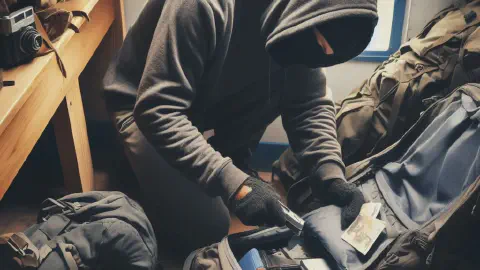
Travel Insurance
Travel insurance is a crucial aspect to consider when planning for a trip, especially for a journey like the Camino de Santiago. One of the key components of a comprehensive travel insurance policy is coverage for theft and loss. This coverage is designed to protect you in the event that your personal belongings, such as luggage, travel documents, or valuable items, are stolen or lost during your trip.
It’s important to consider the value of the items you’re bringing with you, as this can influence the level of coverage you may need. Some policies may have limits on the payout for individual items or categories of items, so it’s essential to read the policy terms carefully. In addition, some insurers may require you to take certain precautions, such as using a hotel safe or not leaving items unattended, in order for a claim to be valid.
Therefore, understanding the specifics of the theft and loss coverage in your travel insurance policy can provide peace of mind and financial protection, allowing you to focus on enjoying your journey.
It can also be worthwhile making a list of all the items that you are carrying (including cash, travelers cheques and credit cards), along with their value and do take a photograph of each item before you leave.
Is Theft a Serious Problem on the Camino or a Manageable Risk?
Pilgrims traversing the Camino de Santiago share contrasting narratives concerning theft and its prevalence along the route. To some, it constitutes a significant deterrent, injecting a note of precaution and paranoia into an otherwise spiritual and transformative journey.
A perspective, it can be argued, that is exponentially amplified by victimization. Petty crime, albeit limited, disrupts the essence of trust, community, and peace that embodies the Camino experience, moving it from the realm of the manageable risk to a more serious problem.
Conversely, another school of thought identifies petty crime as an inherent risk, no more prevalent on the Camino than in other public spaces frequented by tourists and locals alike.
The proponents of this view argue that common sense precautions and vigilant behavior usually suffice, making theft a manageable risk rather than a pervasive problem and while unfortunate, should not overshadow the overarching spirit of camaraderie and goodwill that prevails on the Camino.
Pilgrim Scams on the Camino de Santiago: How to Spot and Avoid Them
Pilgrimage journeys, although a quest for spiritual fulfillment, are not exempt from the realities that mar our society. One such menace is the scams that target these unsuspecting travelers, making them victims of exploitation, often leaving them bereft of their belongings. The nature of these scams can range from straightforward stealing to sophisticated frauds executed with thorough planning.
Common Pilgrim Ruses and Deceptions: How They Work
Here are a couple of the most common con tricks:
The Friendly Helper Trick
One common scam that tends to be rampant is the ‘friendly helper trick’, especially used in bag snatching incidents. Michael Stewart, a British pilgrim in 2018, reported a friendly local offering to help him carry his backpack, while diverting his attention by engaging in light conversation about local folklore. Suddenly, the well-intentioned helping hand vanished with all of his money and passport.
Another striking example is of an American pilgrim, who fell victim to an intricate scam. A friendly stranger approached, offering assistance with her heavy backpack. Seeing an apparent act of kindness, she accepted, only to realize later that all her cash and passport had been deceitfully taken from her pack. What was supposed to be a freeing journey turned into days of struggle as they had to navigate foreign embassies to reestablish her identity. The perpetrator, unfortunately, was never identified. This incident underscores the look of these scams – altruistic on the surface, deceitful on the inside, and impeccably timed to take advantage of the trust of these pilgrims.
The Phantom Hostel Scam
Another prevalent deception pilgrims can fall victims to lies in the realm of accommodation—the ‘phantom hostel scam.’ Upon reaching Santiago, a British pilgrim, exhausted from her journey, found herself being approached by a young Spaniard who offered her a room at a new, cozy Albergue off the usual trail. Charmed by his hospitable gestures and enticing description, she followed him, only to be led to a secluded spot, where he demanded all her money. He disappeared as quickly as he had appeared, leaving her penniless and stranded in a land foreign to her. These incidents reflect the unfortunate trend of thievery and deceit marring the spiritual journeys of countless pilgrims each year.
Accounts of Pilgrim Robberies: How They Happened
Another incident which took place in Larrasoaña, a town along the Camino trail unfolded as follows: An experienced trekker from Dallas, Texas, was en route to her hostel when her backpack – containing her passport, cash, and other vital essentials – was swiped from her as she rested at a local café. Navigating the loss was particularly challenging without the necessary identification or money. The local authorities swiftly took action and, after two days of investigation, were able to apprehend the culprit – a local miscreant notorious for his exploitative activities targeting unsuspecting pilgrims.
Another reported incident happened to a British retiree walking the Camino to fulfill a lifelong dream. Thomas was in Portomarín when he became a victim. His money pouch, which he kept hidden under his shirt, was adeptly cut off while he was engrossed in appreciating the historic Church of San Juan. Besides losing all his travel funds and some private keepsakes, the devastated Pilgrim had to deal with complex bureaucratic procedures to get emergency funds from home. The thief was never caught, highlighting the proficiencies these con artists possess and the need for heightened vigilance.
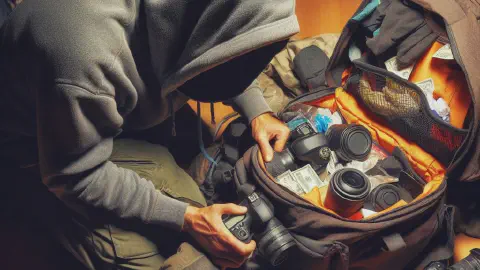
Tricky Situations: Incidents of Pilgrim Burglaries
Certain locations along the Camino route, especially those known for their limited lodging or remote nature, have unfortunately become crime hubs. One unsettling account dates back to April 2013, when an American pilgrim, was targeted during his stay near the provincial town of Léon, Spain. His rucksack, which contained belongings, cash, and his passport, was taken from his bunk at a communal hostel while he was out for an evening stroll.
The actions of some opportunistic wrongdoers can disturb the pilgrim’s peace of mind considerably. A similar incident occurred in June 2018, when a lone traveler from Taiwan, reported a burglary at the Roncesvalles Albergue. She discovered her sleeping compartment had been rifled through, and several precious belongings were missing. For her, dealing with the aftermath of such incidents distorted her perception of the Camino, as she lost not only her possessions but also a sense of comfort and trust that was integral to her journey. Despite the actions of the authorities in apprehending these criminals, the repercussions for the victims bridge both material loss and emotional trauma.
How to Avoid Theft in a Camino Albergue
Here are some tips to avoid theft in an albergue on the Camino de Santiago:
- Don’t leave your backpack unattended on the bed.
- Use a safety belt/fanny pack, and always take your valuables with you, even to the shower and toilet.
- Don’t draw attention to yourself.
- Never leave money, passports, cell phones, etc. lying in plain sight. Even tucking them under your pillow isn’t a good idea, that’s the first place a petty thief will look!
- More and more albergues have lockers, with a magnetic key they offer or you own. So do bring your own lock.
- If you must leave your backpack behind with your gear in the albergue, carry tech devices and oter valuables and ID with you when you leave.
Remember, most people keep their valuables on them at all times. It’s nice like to think that pilgrims are honest people, but it’s always best not to leave temptation in anyone’s way.
Pickpockets on the Pilgrimage Route: How They Operate
Intricate scams and crafty deceit have been common phenomena along pilgrimage routes worldwide, with pickpocketing gaining prominence as one of the most prevalent methods of separating someone from their possessions. Picture the case of a devout pilgrim, who experienced heart-wrenching thievery on the revered path to Santiago de Compostela, in August 2018. As he engrossed himself in the spiritual serenity of the Camino, a deceptively friendly fellow pilgrim targeted him, swiftly snatching his wallet from his loosely zipped backpack. The abrupt realization of his empty pockets left him stressed and financially disadvantaged in a foreign country.
The consequences for such perpetrators, when caught, have been far from lenient. In a similar instance that took place in February 2020, a seasoned pickpocket who had made a notorious career out of exploiting unsuspecting pilgrims on the same Camino de Compostela route, finally faced justice. The relentless diligence of the local police followed his trail and they nabbed him red-handed just as he was about to relieve another unsuspecting victim of her valuables. The swift hand of justice lead to the pickpocket receiving an extensive jail sentence for his numerous audacious crimes, instilling a sense of justice and safety among the pilgrim community.
Ways to deter pickpockets:
- Don’t wear your valuables like they’re fruit waiting to be plucked.
- Keep your hands on your bags at all times.
- While dining, rest your handbag on your lap.
- Wear your neck purse under your clothes.
- Count out your own money when buying souvenirs.
- Be a difficult target, walk with purpose, and keep moving.
- Be unpredictable.
- Be cautious when talking to strangers.
- Avoid shaking hands with a stranger.
- When traveling in groups, designate lookouts to avoid pickpockets¹.
- Never use your back pocket.
- Secure your bag, gadgets, and other valuables when you’re out and about¹.
- Use a money belt or neck stash.
- Store your wallet in your front pocket and keep your belongings close at all times.
- Choose a purse with a complex latch to deter pickpockets.
- Avoid rummaging through your wallet to count money.
- Keep moving and stay purposeful.
Remember, pickpockets are very skilled at what they do. They know all the tricks and are extremely light-fingered with most incidents only taking a second or two. So, always be aware of your surroundings and follow your instincts.
Bag Snatching Incidents: How They Occur
Though one may not imagine that pilgrimages and spiritual journeys could be burdened with such lowly earthly vices, the reality signifies differently. The Camino witnesses numerous cases of unobserved bag snatching incidents – a reality that often goes unnoticed by pilgrims until the calamity has already struck.
Take, for instance, a case in September 2018. A pilgrim had temporarily left her backpack on a bench to admire the beautiful Santiago de Compostela cathedral. In the fleeting moments of her distraction, her bag vanished – no suspect in sight, no plausible explanation – only an empty bench and a gaping loss staring back at her. Her passport, cash and other personal belongings was in her backpack, which created an array of bureaucratic challenges for her return journey home.
Dipping further into the past, a similar incident occurred in July 2015 to a seasoned pilgrim. He was not a novice, and yet, while he was enjoying a well-deserved lunch at a quaint café, his backpack, carefully hung on his chair, disappeared into thin air. The consequences were dire – in his bag were his heart medications, without which he fell seriously ill, causing his journey to end prematurely.
Both incidents share a common thread: the bags were snatched when they were the least suspected: one in broad daylight amidst a crowd, the other stealthily from behind when the owner’s guard was down. Notably, these illegal activities often happen silently without catching anyone’s attention until it’s too late.
How to Avoid Bag Snatching
Here are some tips to avoid bag snatching incidents:
- Do not leave your purse in your shopping cart or on a counter – not even for a moment.
- Do not hang your purse on the back of your chair.
- Do not leave your belongings unattended on a table or chair beside you in a restaurant.
- Be fully aware of your surroundings all the time.
- Walk with your head up and your shoulders squared.
- Hold your purse securely.
- Use a purse with secure closures.
- Use a purse with a cross-body strap.
- Avoid designer bags.
- Keep valuables out of sight.
- Consider buying trousers with zippable pockets.
- Always lock bags with a sturdy padlock.
- Carry backpacks or messenger bags in front of you in high-risk areas.
- Carry only a few one dollar bills in your purse.
- Carry credit cards, currency, driver’s license, keys, and jewelry in a coat or sweater pocket, or concealed on your person.
- Choose a cross body purse and always wear the strap across your body.
- Avoid carrying all your valuables in your travel purse in busy tourist areas or when attending markets or festivals.
Remember, the most obvious solution to preventing your bag from being snatched is to leave it at home. Carrying only essential items such as ID, money and keys in your pockets. If however it isn’t convenient for you to carry only these items or you are short on pockets consider using the likes of a bum bag.
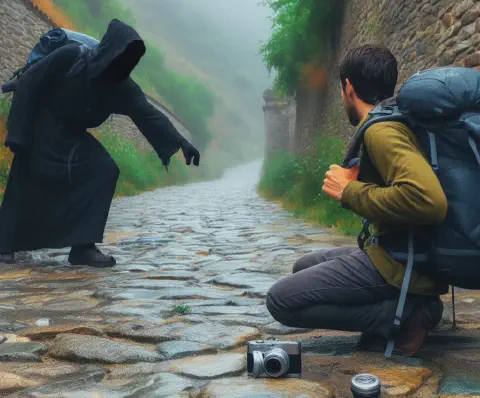
Unveiling the Reality of Pilgrim Fraud: How It Impacts the Victims and the Pilgrimage
The pilgrimage, a journey promising divine rewards and spiritual enlightenment, is not immune to the ugly specter of criminality. A startling example occurred along the stoic path of the Camino in July 2016. A normally cheerful woman in her sixties, fell victim to an elaborate credit card scam. Playing on her trusting nature, an unscrupulous fraudster posing as a fellow pilgrim convinced her to purchase a fake religious artifact using her credit card. The scammer disappeared soon after, leaving her with a worthless trinket and a hacked credit card account. The incident left Maria devastated, and the consequent financial setback completely derailed her pilgrimage.
On another occasion in May 2019, along the same route, another pilgrim reported an unsuspected identity theft occurring during his journey. He had confidently entrusted his travel documents and passport to a seemingly caring and compassionate fellow traveller. The man, later identified as a serial fraudster, used his identification to forge credit card applications. The victim only discovered the crime after returning home to unanticipated credit card bills. Despite the eventual arrest of the fraudster, the Pilgrim his credit rating severely impacted by the incident, leading to significant personal and financial stress. Scams like these serve as grim reminders that the sacredness of pilgrimage cannot guarantee safety from fraud.
Breaking Down the Modus Operandi of Con Artists
Deception is an art for pilgrim con artists. With their expert manipulation tactics, they make the innocent pilgrim trust them enough to divulge sensitive information. Often, they pose as fellow pilgrims and ask about your lodging details, planned itinerary or about valuable possessions. One such case took place on the Camino in 2015, the Pilgrim fell for a friendly stranger’s conversation. Later that night, the con artist, who knew his accommodation details, robbed him of his money and crucial documents while he was sleeping. The loss not only shook him mentally but he also had to face the hassle of getting his documents replaced from the embassy.
Another common modus operandi is distraction, a technique widely used by con artists. In 2018, a Camino pilgrim fell victim to this approach. While he was busy observing a street performer, a faux pilgrim bumped into him, successfully stealing his wallet in the commotion. His money, credit cards and ID were all in the wallet. Frank’s journey was interrupted, as he had to work his way back to get his identification proof. Meanwhile, the perpetrator remains undetected, the crowd and the ensuing chaos making it easy for him to blend in and escape.
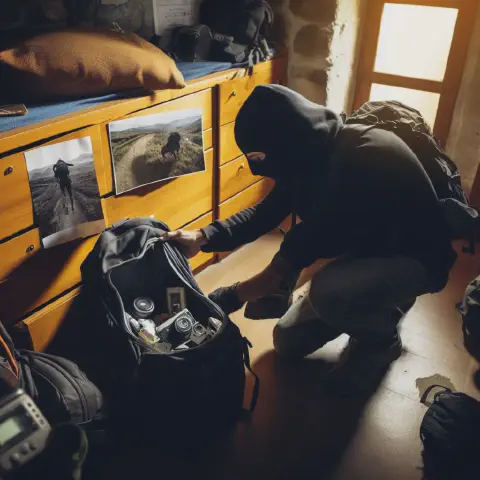
Safety Measures to Avoid Becoming a Theft Victim: How to Be Vigilant and Prepared
Educating oneself on common scams and potentially dangerous situations is the first step to ensuring a safe pilgrimage journey. An American pilgrim embarking on her journey to Santiago de Compostela learned this the hard way. Having lost her purse filled with cash, credit cards, and her passport, she was left distraught and helpless in a foreign land. Disoriented and desperate, she had to rely solely on the goodwill of fellow pilgrims and local benefactors to complete her journey. On her return, she championed the importance of being cautious, personally sharing her experience to help others avoid falling into similar unpleasant circumstances.
One of the most effective safety measures one can take is to keep personal belongings within sight at all times. All the examples here instances highlight the importance of vigilance and awareness during pilgrimages. Hence, the key to safety, it seems, lies not only in faith but also in a healthy sense of suspicion and an observant eye.
Here are some tips to avoid con artists, scams and theft while traveling in Spain:
- Be Aware of Your Surroundings: Always be alert and aware of your surroundings. This includes being mindful of your belongings and not leaving them unattended.
- Dress Like a Local: Try to blend in with the locals as much as possible. Avoid wearing excessive jewelry or carrying expensive cameras that might attract attention.
- Avoid High Pressure Sales Tactics: Be wary of anyone who tries to pressure you into making a quick decision or purchase.
- Recognize Common Fraudulent Schemes: Be familiar with common scams and fraudulent schemes. This could include someone posing as an agent for the Internal Revenue Service, or someone offering services and asking for advance payment.
- Be Skeptical of Too-Good-To-Be-True Offers: If an offer sounds too good to be true, it probably is.
- Report Suspicious Activity: If you suspect that you’ve been targeted by a con artist, report it to the local authorities immediately.
Remember, the best way to avoid falling victim to a scam is to stay informed and vigilant. Safe travels!
Frequently Asked questions (FAQ’s)
How prevalent is theft on the Camino?
The extent of theft on the Camino can vary, but it’s not considered to be a rampant problem. The most targeted items are generally small and easily accessible such as money, electronics, and personal documents.
Who are usually the perpetrators of theft?
The individuals who commit thefts on the Camino may range from opportunistic individuals to small groups who specifically target pilgrims. Their motivations often include financial gain, but can also be driven by other factors.
How does theft impact the victims and the overall pilgrimage?
Theft can have a significant impact on victims, causing distress and disrupting their pilgrimage. On a wider scale, frequent instances of theft can potentially diminish the spirit of camaraderie and trust amongst pilgrims on the Camino.
What preventive measures can be taken to avoid theft?
To avoid theft, it is recommended to keep valuables close at all times, use lockers provided at accommodations, and avoid displaying wealth. Being aware of your surroundings and maintaining vigilance is also essential.
What steps can be taken if one becomes a victim?
If you become a victim of theft, report the incident immediately to the local authorities. You can also seek help and advice from fellow pilgrims or from staff at local establishments.
Is theft a serious issue on the Camino or just a manageable risk?
While theft does occur on the Camino, it’s generally seen as a manageable risk rather than a serious, widespread problem. By taking appropriate precautions, pilgrims can greatly reduce their risk of becoming victims of theft.

